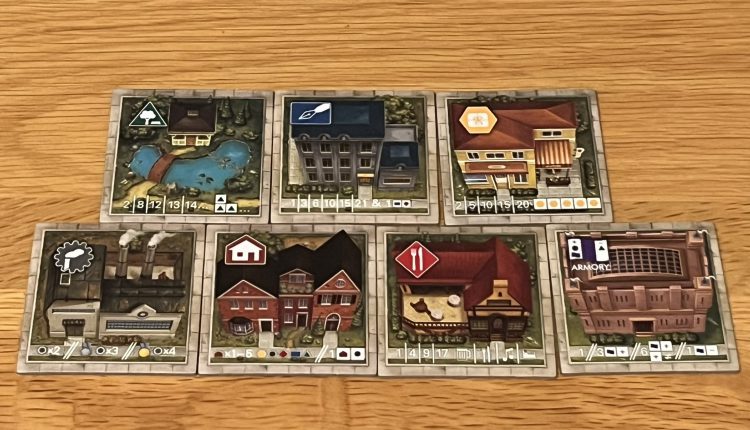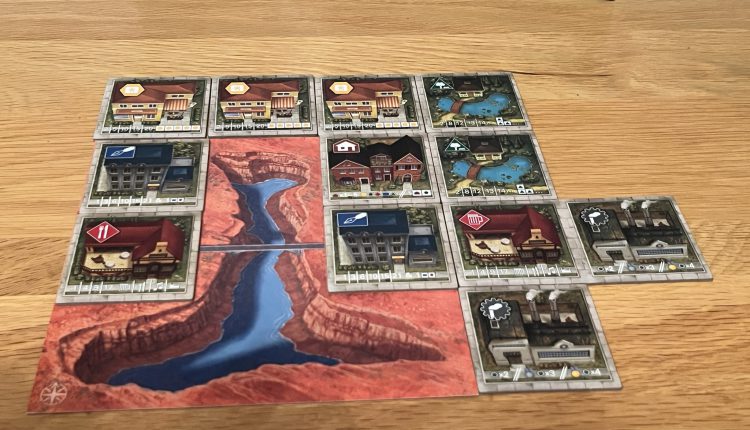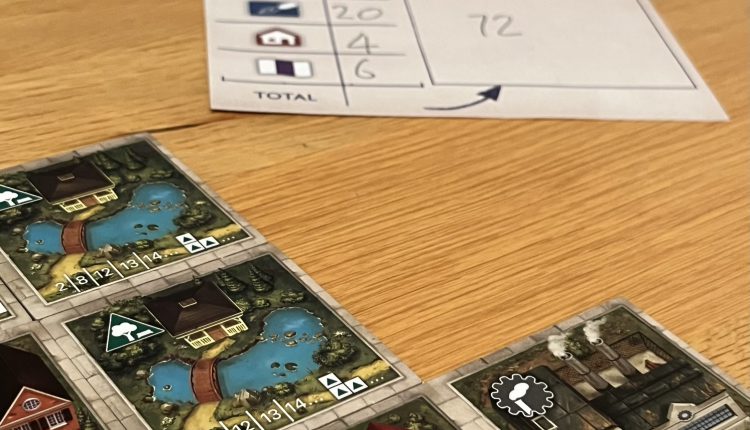Between Two Cities: Essential Edition – Create Your City
Split your planning and optimizing skills between two competing cities as you plot the perfect placements in this updated tile laying classic from Stonemaier Games.
Casting players as renowned city planners, Between Two Cities is a tile laying and drafting game for up to 7 players that challenges players to divide their attention between a pair of cities. Each player collaborates with the person to either side to craft the best city possible. At game end each city is scored, a player’s final score is the lower of the two cities they helped design. Between Two Cities demands a careful balancing of competing choices and priorities to win, let one city fall too far behind and victory will slip away.
Between Two Cities: Essential Edition brings together the original game and the content of the Capitals expansion in one box as well as offering a handy new scorepad and some tweaks to the original artwork but there are no gameplay changes. If you already own the Capitals expansion, you’re good to game.
Between Two Cities is played over three rounds. Each player will begin with a landscape matt to either side of them representing city locations, thus each player will sit between two competing cities. Landscape matts are a 3×3 grid that must be incorporated into your city, each features several plots where tiles can’t be placed, and each has a different layout which challenges players to adapt their tile placements in different ways as they chase tile adjacencies. When completed each city must take the form of a 5×5 square including the landscape matt.
In the first and third round players are dealt stacks of building tiles. Simultaneous turns are taken selecting two tiles (one for each city) before the remaining tiles are passed to the next player. Players then freely discuss with the person to either side before placing one tile in each city they sit between. 
There are six categories of buildings represented by tiles, each of which is scored differently. Shops need to be placed in neat connected vertical or horizontal rows, while offices are simply scored by how many you have in your city and each civic building has its own unique scoring criteria based on which building types it benefits from being adjacent to. After each pair of placements budding city planners choose their next pair of tiles from the stack just passed to them and so on. In this way each city is built up tile by tile at the same rate until the stack only has one tile left signalling the end of the round.
The second round works a little differently. Each player receives three double tiles and must choose two, one for each of their cities. Each of these double tiles is already predetermined as vertical or horizontal and must be placed within the forming 5×5 grid. This can be quite a challenge and often results in some sub-optimal placements.
So, is all this tile tension any fun? At its heart Between Two Cities is a tile placement puzzle that forces the player to constantly make interesting and satisfyingly crunchy choices between two equally important cities every turn. Let’s say you’ve just drafted a shop and a factory. You could squeeze that shop in as the third and final in a row (because that pesky lake got in your way and you had to put your double tile somewhere!) to bag you ten points. Or maybe it belongs as the first shop in a potential full column of five that city B still has space to accommodate because you’ve been saving it in the hope of such an eventuality, but that’s risky, what if you don’t draft many more shops? After all it’s the lowest scoring city you will carry forward for your final score.

So, you play the long game and the shop tile goes down on city B, which means A must get the factory but where to put it? Because you don’t want it next to the residential area, so maybe it could go next to the park, but then how are you going to make sure you can get a tavern adjacent to all those offices to get the bonus? And that’s just your tiles, your co-planner has a tile for each city that he needs to squeeze in advantageously too.
There’s also an intriguing memory aspect to the tile drafting. You’re trying to collect a full set of tavern types, but you might pass up on that for now and leave it in the stack as you really want to take that factory to make sure you have the most for game end, because your currently level with one of Susan’s cities and factories are scored based on majority at game end. However that means passing up on the tavern, what if someone picks it before it comes back around the table and the right type isn’t in the other stacks? Keeping track of the tiles in this way is a fun side quest at three or four players but at six or seven it became mind boggling making long-term planning more challenging.
Between Two Cities is one of those great game designs delivering a complex and engaging puzzle from a pleasingly slimline ruleset. Newcomers can pick up the game in a few minutes, but of course learning how to optimize every tile placement is a real journey to mastery. Though with two tiles to place between two cities you might need to watch out for analysis paralysis from those who like to take their time.
The scoring system and co-operative nature create a real drive to make balanced and mutual decisions rather than just focus on a favoured city. With only twenty tiles placed altogether per city you really need to work together to plan for the best outcomes, while of course keeping one eye on your own prospects. Between Two Cities is a delightfully tight puzzle that maintains its tension until the final turns, we found that there is very rarely a runaway winner which makes for a better experience for all.
As mentioned, the essential edition includes all three of the modules from the Capitals expansion so once you’ve got to grips with the core game (it now already uses two of the modules from the get-go) you can add the districts module for extra variability. The districts module challenges players to build the biggest continuous area of two given tile types for game end points, creating another interesting decision point, prioritize district size or stick with the standard tile scoring requirements? 
Between Two Cities is a great gateway experience with an interesting co-op twist on a very well-established theme, earning itself a well-deserved spot on your shelf. Though it must be said some of the iconography and scoring ques on the tiles could be clearer (particularly the civic buildings), especially when compared to the likes of Suberbia, over all Between Two Cities is a great game for getting a large group round the table quickly. If you enjoy the theme but want to focus more on your own city while still having some interaction, Suberbia is a great pick, or for a little more complexity on a similar theme try Castles of Burgundy.
You can purchase Between Two Cities on Amazon.
Comments are closed.